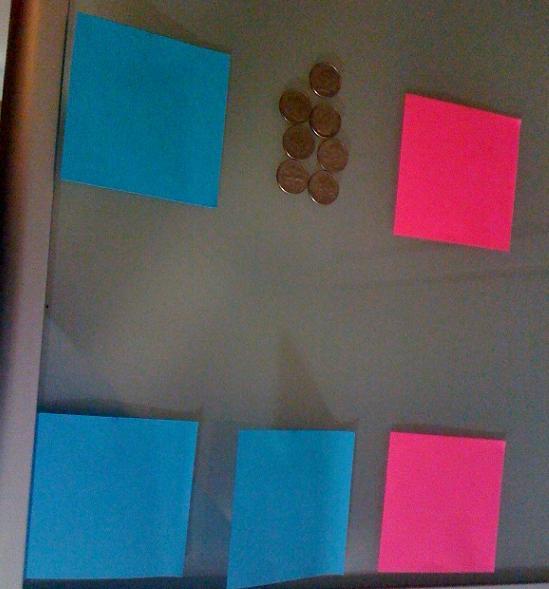Beginner's mind: seeing the mathematics
Posted by: Gary Ernest Davis on: January 22, 2010
My colleague has a Ph.D. in mathematics and two young children – 9 and 11 years of age.
She writes the following account of her children’s engagement with a word problem:
Yesterday my 9 year old was struggling with the following problem:
“Suzi and Joey had the same amount of money. Then they went shopping. Suzi spent $18 and Joey spent $25. When they were done, Suzi had double the amount of money Joey had. How much money did Joey have left?”
Another, helpful, adult was trying to assist him, introducing all kinds of X’s into the problem. While he now understood the answer, he didn’t understand why it worked that way. So they came to ask me to explain it.
I looked at the problem and formulated it in my mind:
2X+18 = X+25
so X=7.
Before starting to explain the problem, I restated it.
My 11 year old son, who was reading nearby, immediately said “7”.
I asked him why, and he explained that that was the amount that Joey spent more than Suzi, and that is half the amount that Suzi had left.
It seemed very obvious to him: he just “saw” it.
I must admit (shame-faced) that it was not all that obvious to me until he explained it. I was thinking of the problem procedurally, whereas he immediately saw the relationships between the numbers. In Skemp’s terms, I, the expert, was thinking instrumentally, and he, the beginner, was thinking relationally.
Now to explain it to my 9-year old, I used the tools on my desk.
First I took a turquoise post-it note and 25 coins and put it on one side, and 2 turquoise post-it notes and 18 coins on the other side.
I grouped the 25 coins into 18 and 7. Now it was obvious that on the two sides on the desk, the 18 coins on each side paired up (i.e were equal), a turquoise post-it on each side had a pair on the other side, and the remaining seven must then be equal to the second turquoise post-it.
To abstract it a little more, I replaced the 18 coins on each side by a pink post-it.
This was to represent that it really doesn’t matter HOW MUCH money each spent, but only the difference between the two.
Now, of course, it was “obvious”, even to a mathematician with a Ph. D.
So I have 2 questions:
1. How do we train someone to see this problem relationally and not procedurally and instrumentally?
And, more critically:
2. How do I make sure not to ruin the understanding my 11-year old has, when teaching him to do this procedurally?
10 Responses to "Beginner's mind: seeing the mathematics"
In 1984 Algebra 11 was a required course for university entrance, so star quarterback JQ really needed to pass the course. He struggled until we hit word problems. He invariably “saw” the answer, like the 11 year-old above. Sometimes he could explain how he arrived at the answer, more often not. JQ is a successful businessman today and I still refer to his intuitive approach (Skemp’s relational thinking). As the writer says, to not “ruin the understanding” of her son is a critical issue, and one that I am not seeing addressed in mathematics education circles. We need problem-solvers, not necessarily problem-explainers.
Impressive.
Reminds me of the story of Feynman and the boat problem. You’re rowing a boat at 2 mph in a stream that’s moving 4 mph. You drop your hat in the stream but don’t notice it for 1/2 an hour all the while you’ve been rowing downstream. How long does it take you to row back and retrieve the hat? While everyone else futzed with vectors, he saw the answer and wrote it down immediately.
This need not be an either/or situation. We should be encouraging all problem solvers to pursue multiple parallel solution paths to a problem whenever possible. Each path serves as a check for the other, and if both produce the same result, you can be twice as confident that it is a correct one.
Intuitive problems solvers can continue their intuitive approach as they also (learn to) solve the problem in more procedural ways. Both approaches are important and useful skills to master, because sometimes they may not get anywhere with one approach while the other will work nicely for them.
Having multiple tools in their box, and building their ability to judge from their own experiences when each tool is likely to work best for them is just as valuable in math as it is in carpentry.
Whit Ford
http://mathmaine.wordpress.com
As to the two “How” questions… it seems that while there are indeed multiple learning styles, one or more of them may not really work for a particular student at a particular point. To work around this problem, multiple approaches to each problem should be encouraged and taught whenever possible.
Most intuitive solutions seem visual to me (is that because of my learning style?), and your colleague laid this solution out in a nice visual way. I have the impression that visual approaches are not considered as often as procedural ones in the average classroom, just as “why” questions are often not answered by a teacher until someone asks them. So, I would advocate covering a visual analog to each process being introduced (whenever one can be found) as one way to produce more intuitive problem solvers. Use of number lines for addition, rectangles for distributing multiplication over addition, etc. are good examples of this.
I would think that this same approach would also help avoid the second concern: having procedural approaches replace intuitive ones as the student’s primary approach. By giving equal weight to alternative approaches whenever possible, and asking students to use all possible approaches to problems on a regular basis so they gain personal experience with each, we should be able to encourage them to both continue building on their strengths, while simultaneously strengthening their weaknesses.
This problem is very similar to the type of word problems found in the Singapore Math series. Students are taught to solve these problems using bar models. I posted a bar model solution here: http://www.mathplayground.com/images/mathproblem.gif
We use the model method with students as young as grade 2 at my learning center. If they stay with it, they can solve (and understand) fairly complex algebra problems by 5th or 6th grade.
To answer the first question, I think using the model method consistently during the early stages of math development does train students to see math problems relationally. I see major differences in problem solving approaches when comparing students who have learned the model method with those who have not. The extensive training in visualization that comes from applying the model method has long term effects. Former students, now in college, have shared that they continue to model problems when a solution is not immediately evident. In fact, it even seems to transcend math. Students are modeling problems in chemistry, physics, and computer science.
Question 2 is an important one. Is your colleague homeschooling her children? If so, she could always ask her son to give his intuitive answer first and then ask him to use procedural knowledge to confirm it. As Whit stated, multiple approaches should continue to be emphasized. I find that once students move on to algebra, the procedural method is often the only way students are expected to solve problems. Alternative methods should always be encouraged.
Awesome example of how “A Picture=1000 words.”
A picture can disarm any mathematical problem. I think PICTURES are one of the most effective Applied Tools of Mathematics (ATOM) that we can use to energize learning and Multiply Leadership in the classroom.
Pictures are not just teaching tools, they are also consulting tools that can hit home runs!
Mark
http://www.MultiplyLeadership.com
@MultiplyLeaders
I agree. One of my first memories is that of my father and I ‘skinning tigers’ in our front yard. That is to say, in skinning any cat, we should always encourage both tactical, strategic, and situational thinking when approaching a problem. Students quickly learn that each has its advantages & parallel thinking is fun.
[…] dear reader, also becoming obscured by knowledge? Possibly related posts: (automatically generated)Beginner’s mind: seeing the mathematicsThe Anthropology of […]



January 22, 2010 at 9:17 am
I’m curious if your son didn’t just luck out.
By that, I mean that 25-18 is clearly seven and he could have just randomly done the subtraction without thinking about whether it yielded the correct result. Had you asked how much Suzy had left would he have realized that he needed to double the difference?
January 22, 2010 at 1:19 pm
My colleague replied:
“Yes, I asked him how much Suzi had and how much they both had initially and he knew it immediately. In fact, he explained it to his brother in this way, and later we did it visually based on his explanation.”